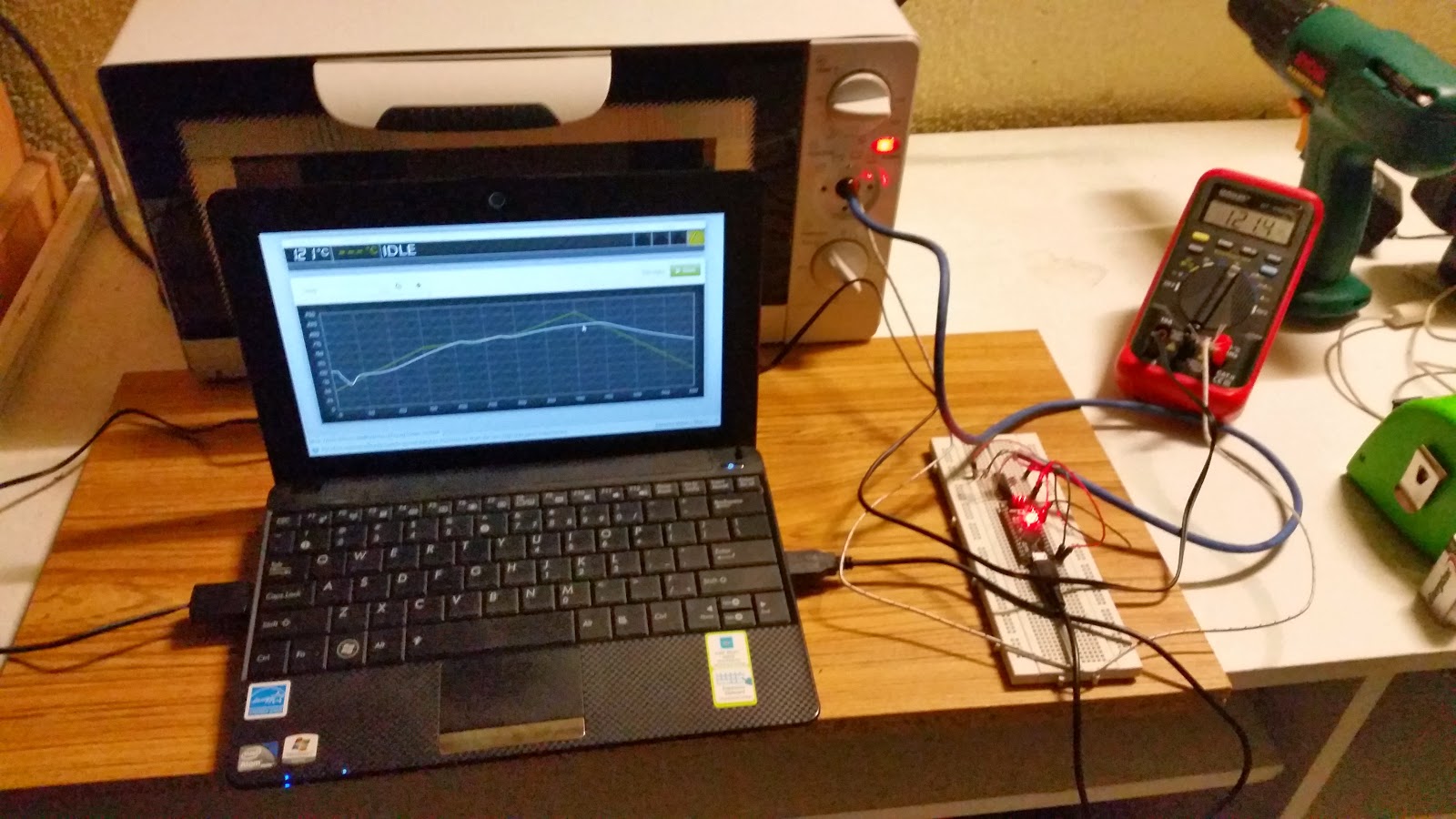After a few boards I got sick of soldering 0603 components using a soldering iron and started looking into using solder paste and hot air. I bought a hot air rework station from Rhinotools. It looks nice, but is rather noisy to use, and I find myself going for the iron always instead of the hot air gun.
The next step in the soldering tools exploration was a classic toaster over reflow. The boards I usually solder are rather small and not panelized, so I do not need a large oven. The smallest decently built oven cheap oven I could find was a K-Mart Homemaker 14L model with 1300W heating power. I also backed an Arduino Leonardo based reflow controller on Kickstarter - ControLeo2. While waiting for the controller to arrive from the US, I got itchy fingers and started hacking together a controller from bits I had lying around.
The ControLeo2 is impressive in being a 4 output reflow controller, to fully utilise this I ordered 4 cheap Fotek relays. They are rated at 25A, and the elements in the toaster consume about 3A each, so there is plenty left over. I would have liked to get a Crydom relay, but they are rather expensive. There is plenty of space in the controller compartment to fit all the 4 relays in, what I will control with them is another matter. Only 2 are needed to control this particular oven as it stands, 1 for the top and 1 for the bottom. The other 2 are planned for the booster element and a cooler of some sort.
Mounting the relays in the case requires some angle brackets, I found these at Bunnings which exactly fit the holes in the SSR with pre-drilled holes. They are galvanised steel however, not the best for heatsinking relays, but they are a good start. I am going to make some proper brackets with bent aluminium bars, but that can wait.
The initial controller was built using the BeagleBone GPIO's. There is the popular Adafruit GPIO library, but I used the less widely used PyBBIO since it has an included reflow oven controller code. My fork is modified to read temperature from a Digitek 4000ZC multimeter over the serial port using the FS9721 python library. A lot of multimeters, including some of the UNI-T models use this controller, so the adaptation should be useful for anyone with this multimeter at hand and not necessarily a MAX31855 breakout board. The SSR's are wired to the BeagleBone GPIO's via a ULN2003 relay/solenoid driver I picked up at Jaycar.
The BeagleBone arrangement though quite nice lacked a few features in the existing code, particularly support for curve editing and proper PID control. So I looked into another Python based toasterReflow controller - picoReflow. This one has even snazzier GUI and lots of options to create new curves and calculate cost in cents per reflow. I decided to try something different this time and replaced PyBBIO using my Arduino's GPIO capability, since a lot more people probably have Arduinos compared to BeagleBones and Raspberry Pi's. So my EeePC replaced the beaglebone as the main controller, taking in the readings from the DMM over 1 USB port and feeding out the SSR control signals to the Arduino over another USB port. This closed loop looks something like this:
Oven -> Thermocouple -> Digitek 4000ZC -> EeePC -> Arduino -> ULN2003 -> Fotek Relays -> Oven
Overall this works quite well for me and I hope it is useful for someone else attempting to build an oven without a fancy controller with just the bits at hand, yet achieve a nice controlled profile.
The next step in the soldering tools exploration was a classic toaster over reflow. The boards I usually solder are rather small and not panelized, so I do not need a large oven. The smallest decently built oven cheap oven I could find was a K-Mart Homemaker 14L model with 1300W heating power. I also backed an Arduino Leonardo based reflow controller on Kickstarter - ControLeo2. While waiting for the controller to arrive from the US, I got itchy fingers and started hacking together a controller from bits I had lying around.
The ControLeo2 is impressive in being a 4 output reflow controller, to fully utilise this I ordered 4 cheap Fotek relays. They are rated at 25A, and the elements in the toaster consume about 3A each, so there is plenty left over. I would have liked to get a Crydom relay, but they are rather expensive. There is plenty of space in the controller compartment to fit all the 4 relays in, what I will control with them is another matter. Only 2 are needed to control this particular oven as it stands, 1 for the top and 1 for the bottom. The other 2 are planned for the booster element and a cooler of some sort.
Mounting the relays in the case requires some angle brackets, I found these at Bunnings which exactly fit the holes in the SSR with pre-drilled holes. They are galvanised steel however, not the best for heatsinking relays, but they are a good start. I am going to make some proper brackets with bent aluminium bars, but that can wait.
The initial controller was built using the BeagleBone GPIO's. There is the popular Adafruit GPIO library, but I used the less widely used PyBBIO since it has an included reflow oven controller code. My fork is modified to read temperature from a Digitek 4000ZC multimeter over the serial port using the FS9721 python library. A lot of multimeters, including some of the UNI-T models use this controller, so the adaptation should be useful for anyone with this multimeter at hand and not necessarily a MAX31855 breakout board. The SSR's are wired to the BeagleBone GPIO's via a ULN2003 relay/solenoid driver I picked up at Jaycar.
The BeagleBone arrangement though quite nice lacked a few features in the existing code, particularly support for curve editing and proper PID control. So I looked into another Python based toasterReflow controller - picoReflow. This one has even snazzier GUI and lots of options to create new curves and calculate cost in cents per reflow. I decided to try something different this time and replaced PyBBIO using my Arduino's GPIO capability, since a lot more people probably have Arduinos compared to BeagleBones and Raspberry Pi's. So my EeePC replaced the beaglebone as the main controller, taking in the readings from the DMM over 1 USB port and feeding out the SSR control signals to the Arduino over another USB port. This closed loop looks something like this:
Oven -> Thermocouple -> Digitek 4000ZC -> EeePC -> Arduino -> ULN2003 -> Fotek Relays -> Oven
Overall this works quite well for me and I hope it is useful for someone else attempting to build an oven without a fancy controller with just the bits at hand, yet achieve a nice controlled profile.





















